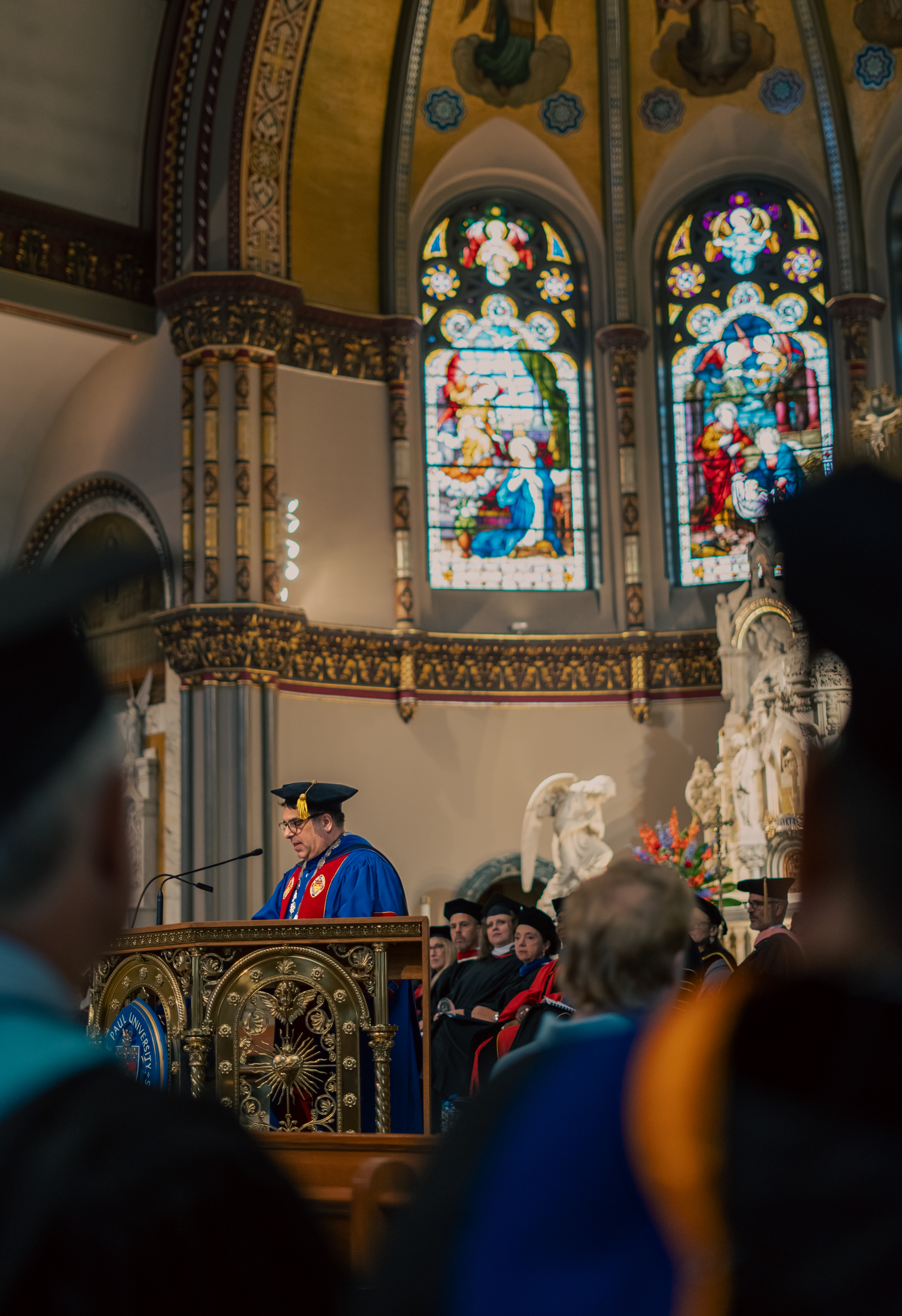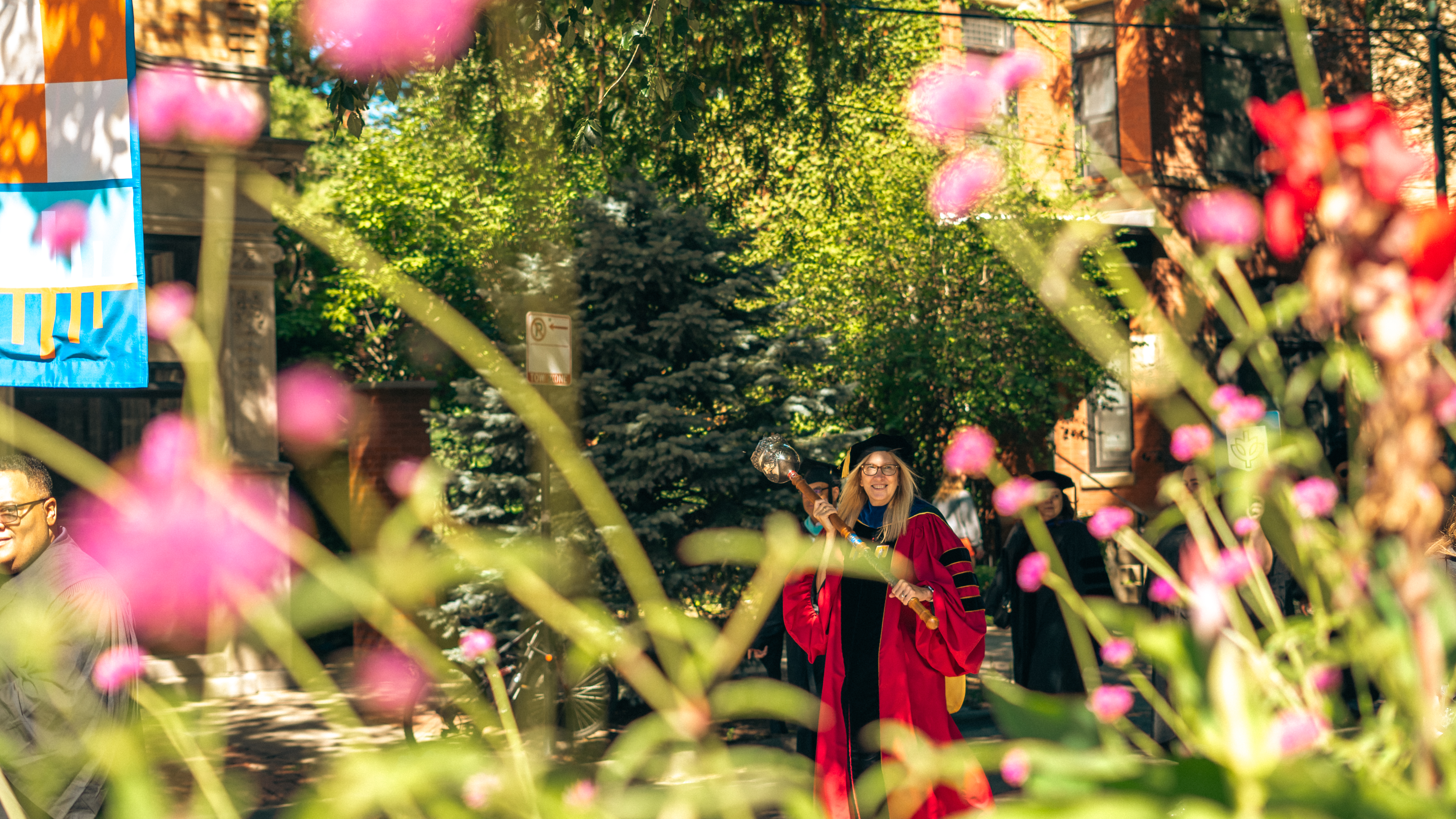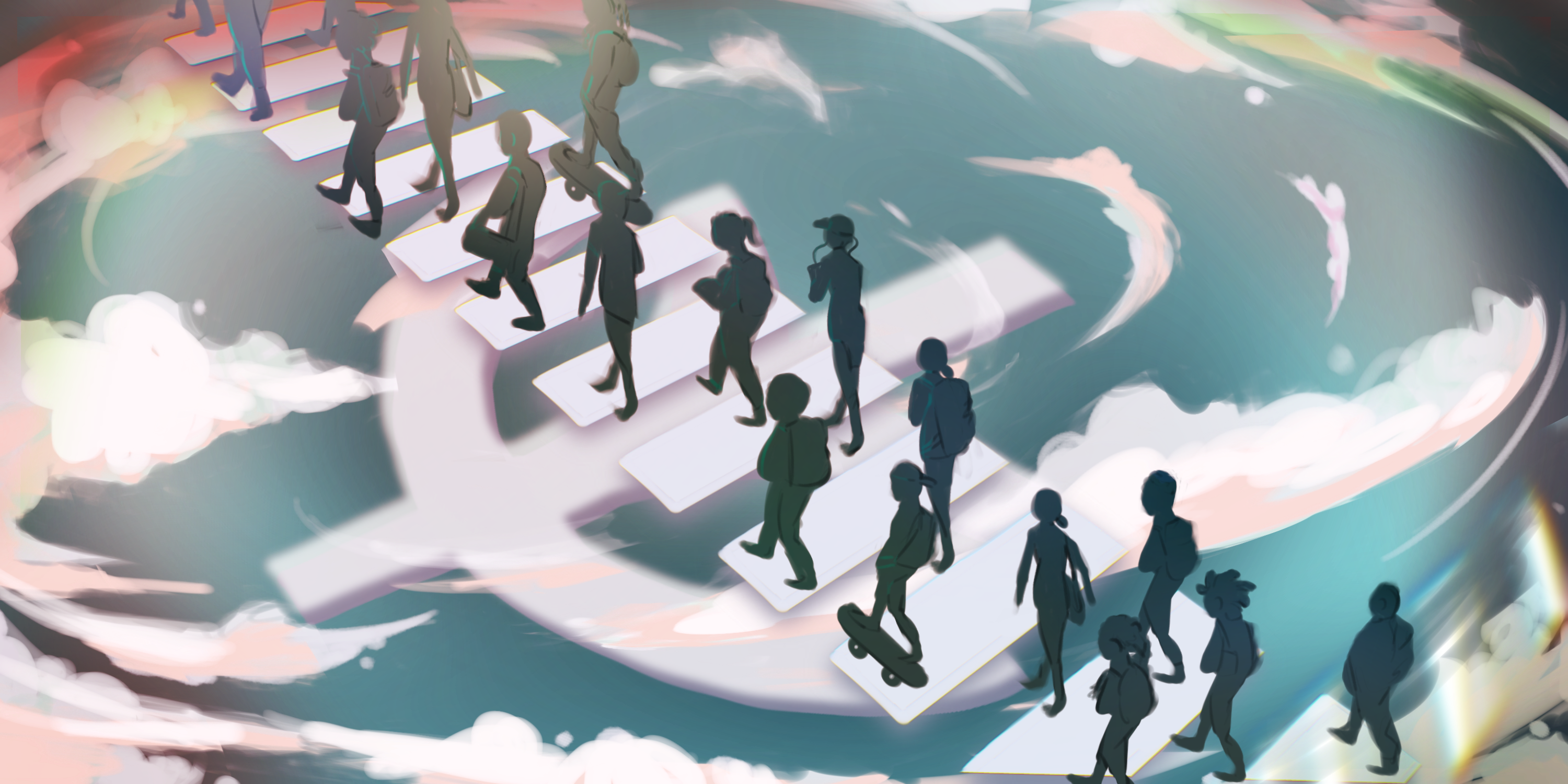The annual DePaul University convocation had key announcements about the future of the university.
As the academic year kicks off, President Robert Manuel delivered a speech Thursday discussing his optimistic future for DePaul as an institution despite the challenges of budget cuts the previous year.
Manuel stated in no uncertain terms that there is nothing strategic about budget cuts. He felt that they were a necessary evil to begin reinvesting.
“I experienced and saw pain, disruption, and fear,” Manuel said in his speech. “I am sorry we had to go through that moment, but I’m truly grateful for your thoughtfulness and care for one another during that time.”

President Robert L. Manuel speaks to the convocation crowd. The president announced several plans at the event. Photo by Varun Khushalani
Last January, Manuel and 3,000 members of the DePaul community began meeting to discuss DePaul’s future. Designing DePaul was created from those 50 meetings.
“It is not a strategic plan. I do not think it is a good idea for a university as complex as we are to have a single plan created from one central office,” Manuel said.
According to the president, the goal of Designing DePaul is to act as a guidepost for the university’s future, made by and for the community.
“It identifies university initiatives that we can begin to execute immediately. Please see these initiatives as an additive to our work – we need to continue to invest and support our existing programs and create new ones.”
The initiatives planned in Designing DePaul include but are not limited to eliminating the retention and graduation achievement gaps between Black and Hispanic students and white students.
DePaul also plans to provide health insurance for students and hosted a summit on September 14 regarding campus safety.
In addition, Manuel stated that a core part of his plan is creating three interdisciplinary institutions focused on poverty, environmental sustainability, and artificial intelligence.
“The institutes will accelerate collaboration among our faculty and deepen our connections with Chicago,” Manuel said in a press release. “DePaul researchers will create a hub where community leaders can access data-driven solutions to stubborn problems. The institutes will help generate robust academic programs that prepare DePaul students to serve in a changing world.”

University leaders walk through the campus. Photo by Varun Khushalani
Professor Mark Potosnak, chair of environmental science and studies, expressed his excitement at the new interdisciplinary research institutions, especially concerning sustainability.
According to him, many throughout DePaul are working to incorporate sustainability into the curriculum. However, most efforts were isolated and did not utilize the community’s collective strength.
“Higher education is changing, and universities need to react to the changing needs of students and the world around us,” Potosnak said in an email. “I am very encouraged that President Manuel has produced a systematic plan to design (maybe redesign) DePaul. I believe DePaul has an outstanding faculty and staff committed to our students. If the execution succeeds, we can put our talent and mission-driven determination to work and help make DePaul a leader among urban universities.”
Professor Bamshed Mobashaer, director of the Center for Web Intelligence at DePaul, proposed creating an interdisciplinary center focused on AI.
He explains the institute’s goals, stating they give people interested in AI but need deep technical knowledge a chance to come together and further explore a technology rapidly emerging in everyday life.
“The goal of the institute is to bring together faculty and others interested in exploring some of these connections with new research projects and possibly new curricular programs that focus on certain domains with a connection to AI,” Mobasher said. “Also, we’ll try to explore how these interdisciplinary projects benefit society. Maybe with external organizations, maybe with nonprofits, maybe even with other companies who are interested in engaging faculty and students on some of these projects.”
While the interdisciplinary institutes will provide opportunities for people to tackle issues more creatively, Mobasher believes President Manuel’s goal is to avoid budget cuts while providing for the school.
“In the longer term, his goal, I think, is to develop outside revenue sources, including funding from donors, through the endowment to support some of these ideas and projects,” Mobasher said. “In the long term, you want these things to become self-sustaining and sources of revenue for the university.”

University leaders file into the church. Photos by Varun Khushalani
The athletics department also expressed excitement at Maunel’s proposed changes to the athletic department, believing a better program will bring in more money for the university.
We need to show our campus partners what having one of the top athletics departments can do for our university,” DeWayne Peevy, director of athletics, said. “I want to see athletics become the true front porch that helps attract prospective student-athletes and all students to increase our enrollment applications by increasing the university’s brand, affinity, and fundraising efforts.”
Peevy expressed his confidence in Designing DePaul, stating that it is a big step in the direction of designing a future for DePaul where they can put its mission first.
“The feedback gained from the university community was strong, and the overall plan laid out is a tremendous vision for the future of DePaul,” Peevy said. “We are excited about the prospect of increasing what we can contribute to the greater university community.
“The dedication to various initiatives like erasing the achievement gap, student healthcare, becoming a Hispanic-serving institution, the endowment of new interdisciplinary funds, and so much more makes it a very exciting time to be at DePaul.”
While there is excitement about the upcoming programs, Potosnak and Mobasher stated, there is still time to judge where these projects will go.
Having lost resources and colleagues due to the budget cuts, Potosnak said everyone involved with the proposed changes must act quickly and intelligently in decision-making.
“I would say I am more excited than confident,” Potosnak said. “The big picture of the plan makes sense, and I know many faculty and staff are anxious to contribute. But execution matters. We need to ensure we have realistic goals and sufficient resources.”
Mobasher expressed his excitement but acknowledged that the journey toward change has only begun.
“I proposed the AI part of this, so I am excited about it and think it is the right move for us to make,” Mobasher said. “I think I support Rob’s vision of creating these interdisciplinary institutes and focusing on some initiatives around these areas. They connect with the mission of DePaul. But there are areas in which we can bring something new into these areas. I think it’s the right move, but how successful it will be remains to be seen. At the moment, this is still a vision. I think we need a lot of work to get these ideas off the ground.”
On the other hand, Peevy expressed his complete faith in the project. With the plan for a new athletic center in the works, Peevy said the budget problems of DePaul will not impact the proposed changes.
“Our project will be funded in its entirety through philanthropic support and corporate naming opportunities,” Peevy said. “Fundraising has already begun, and these projects have several dependencies between them, and dependencies of fundraising goals before certain phases may begin.”
Header by Mei Harter




NO COMMENT